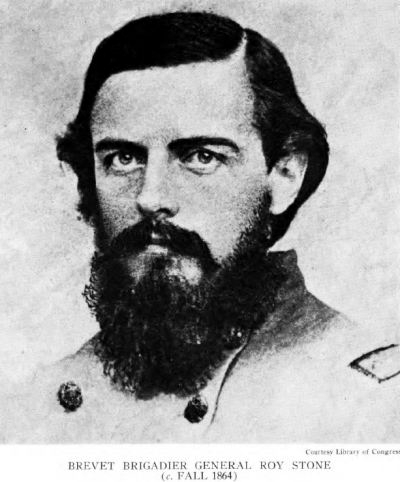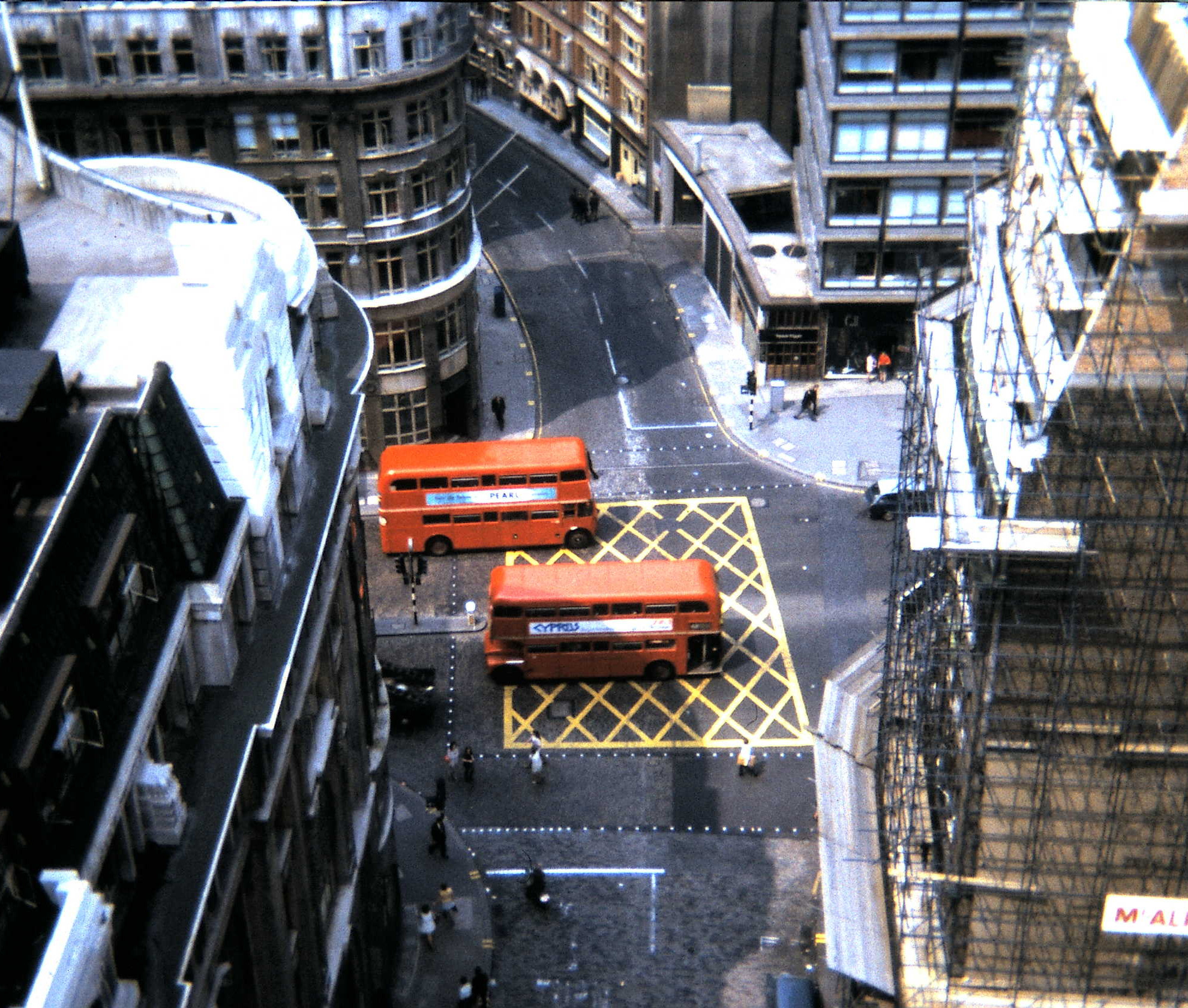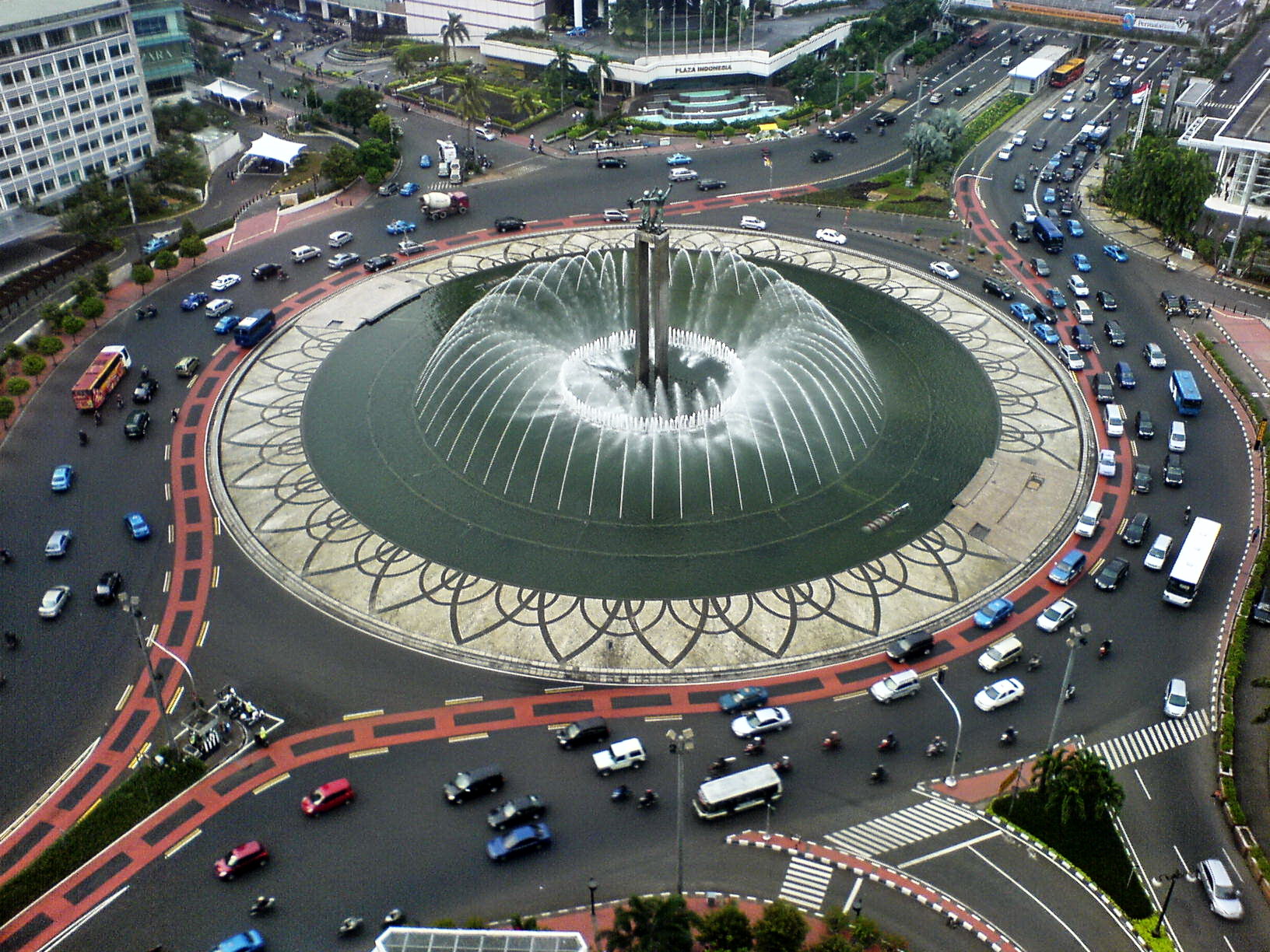|
At-grade Intersection
An intersection or an at-grade junction is a junction where two or more roads converge, diverge, meet or cross at the same height, as opposed to an interchange, which uses bridges or tunnels to separate different roads. Major intersections are often delineated by gores and may be classified by road segments, traffic controls and lane design. This article primarily reflects practice in jurisdictions where vehicles are driven on the right. If not otherwise specified, "right" and "left" can be reversed to reflect jurisdictions where vehicles are driven on the left. Types Road segments One way to classify intersections is by the number of road segments (arms) that are involved. * A three-way intersection is a junction between three road segments (arms): a T junction when two arms form one road, or a Y junction, the latter also known as a fork if approached from the stem of the Y. * A four-way intersection, or crossroads, usually involves a crossing over of two streets or ... [...More Info...] [...Related Items...] OR: [Wikipedia] [Google] [Baidu] |
Stop Sign
A stop sign is a traffic sign designed to notify drivers that they must come to a complete stop and make sure the intersection (road), intersection (or level crossing, railroad crossing) is safely clear of vehicles and pedestrians before continuing past the sign. In many countries, the sign is a red octagon with the word ''STOP'', in either English, the national language of that particular country, or both, displayed in white or yellow. The Vienna Convention on Road Signs and Signals also allows an alternative version: a red circle with a red inverted triangle with either a white or yellow background, and a black or dark blue ''STOP''. Some countries may also use other types, such as Japan's inverted red triangle stop sign. Particular regulations regarding appearance, installation, and compliance with the signs vary by some jurisdictions. Design and configuration The 1968 Vienna Convention on Road Signs and Signals allows for two types of stop signs as well as several acceptable ... [...More Info...] [...Related Items...] OR: [Wikipedia] [Google] [Baidu] |
Quadrant Roadway Intersection
A quadrant roadway intersection adds an additional "quadrant roadway" between two legs of an intersection (road), intersection. This roadway adds two three-way junction, three-way intersections in addition to the original four-way intersection, moving all left turns (in right- and left-hand traffic, right-hand traffic countries) or right turns (in right- and left-hand traffic, left-hand traffic countries) from the main intersection. The design is intended to improve traffic flow by reducing signal timing phases from four to two in the main intersection. The design is intended for intersections where large artery routes meet in an area of dense development and high pedestrian volume. Proponents also point to a reduction in places where accidents could occur from vehicles potentially crossing paths, as well as a low development cost compared to roundabouts or the more complex single-point urban interchange designs. Opponents point to the increase in points where accidents could occu ... [...More Info...] [...Related Items...] OR: [Wikipedia] [Google] [Baidu] |
Hook Turn
A hook turn (Australian English) or two-stage turn (British English), also known as a Copenhagen Left (in reference to cyclists specifically and in countries they are ridden on the right), is a road cycling manoeuvre or a motor vehicle traffic-control mechanism in which vehicles that would normally turn from the innermost lane of an intersection instead turn from the outermost lane, across all other lanes of traffic. Hook turns are commonly used by cyclists as a safer alternative to merging with motor vehicles, or having to cross multiple lanes of traffic to reach a turning lane. The legal use of hook turns by motor vehicles is relatively rare, but has been implemented in some jurisdictions (notably Melbourne, Australia) to keep the centre of a road free from congestion for use by light rail transit such as trams or other dedicated road services. History Hook turns were originally the standard right turn in Australia. Various jurisdictions phased them out at different times. Sy ... [...More Info...] [...Related Items...] OR: [Wikipedia] [Google] [Baidu] |
Continuous-flow Intersection
A continuous flow intersection (CFI), also called a crossover displaced left-turn (XDL or DLT), is an alternative design for an intersection (road), at-grade road junction. Vehicles attempting to turn across the opposing direction of traffic (left in right- and left-hand traffic, right-hand drive jurisdictions; right in left-hand drive jurisdictions) cross before they enter the intersection. No left turn signal in the intersection is then necessary. Instead, vehicles traveling in both directions can proceed, including through vehicles and those turning right or left, when a generic traffic signal/stop sign permits. Its design also is promoted as part of the Federal Highway Administration's Every Day Counts initiative which started in 2011. History A fly-over designed CFI interchange (road), interchange (separated grade) was invented by Francisco Mier. An intersection (at-grade) variant followed. Over 40 have been implemented since 2000. Mier patented his design and required a f ... [...More Info...] [...Related Items...] OR: [Wikipedia] [Google] [Baidu] |
Advanced Stop Line
An advanced stop line (ASL), also called advanced stop box or bike box, is a type of road marking at signalised road junctions allowing certain types of vehicle a head start when the traffic signal changes from red to green. Advanced stop lines are implemented widely in Denmark, the United Kingdom, and other European countries. Description Most commonly associated with bicycles, they may also be provided for buses and motorcycles. There are two parallel stop lines at the intersection, the first one at which all traffic except that for which the facility is provided must stop, and a second one nearer the intersection to which only specified vehicles may proceed. If the signals change to red when a vehicle is crossing the first line, the driver must stop at the second line The area between the stop lines is the "reservoir" or "box". Signage may be required to inform road users as to the meaning of the extra stop line. A separate set of traffic signals may be provided for the sp ... [...More Info...] [...Related Items...] OR: [Wikipedia] [Google] [Baidu] |
Federal Highway Administration
The Federal Highway Administration (FHWA) is a division of the United States Department of Transportation that specializes in highway transportation. The agency's major activities are grouped into two programs, the Federal-aid Highway Program and the Federal Lands Highway Program. Its role had previously been performed by the Office of Road Inquiry, Office of Public Roads and the Bureau of Public Roads. History Background With the coming of the bicycle in the 1890s, interest grew regarding the improvement of streets and roads in America. The traditional method of putting the burden on maintaining roads on local landowners was increasingly inadequate. In 1893, the federal Office of Road Inquiry (ORI) was founded; in 1905, it was renamed the Office of Public Roads (OPR) and made a division of the United States Department of Agriculture. Demands grew for local and state government to take charge. With the coming of the automobile, urgent efforts were made to upgrade and moderniz ... [...More Info...] [...Related Items...] OR: [Wikipedia] [Google] [Baidu] |
United States Department Of Transportation
The United States Department of Transportation (USDOT or DOT) is one of the executive departments of the U.S. federal government. It is headed by the secretary of transportation, who reports directly to the president of the United States and is a member of the president's Cabinet. The department's fiscal year 2022–2026 strategic plan states that its mission is "to deliver the world's leading transportation system, serving the American people and economy through the safe, efficient, sustainable, and equitable movement of people and goods." History In 1965, Najeeb Halaby, was granted authority over aviation and railroads through the commerce clause of the Constitution, the Federal Highway Administration and Federal Transit Administration primarily provided funding for state and local projects, without significant influence over road construction and operation. Halaby emphasized the need for improved coordination and expressed frustration at the lack of an overall plan. " ... [...More Info...] [...Related Items...] OR: [Wikipedia] [Google] [Baidu] |
Jughandle
A jughandle is a type of ramp or slip road that changes the way traffic turns left at an at-grade intersection (in a country where traffic drives on the right). Instead of a standard left turn being made from the left lane, left-turning traffic uses a ramp on the right side of the road. In a standard ''forward jughandle'' or ''near-side jughandle'', the ramp leaves before the intersection, and left-turning traffic turns left off of it rather than the through road; right turns are also made using the jughandle. In a ''reverse jughandle'' or ''far-side jughandle'', the ramp leaves after the intersection, and left-turning traffic loops around to the right and merges with the crossroad before the intersection. The jughandle is also known as a Jersey left due to its high prevalence within the U.S. state of New Jersey (though this term is also locally used for an illegal Pittsburgh left, abrupt left at the beginning of a green light cycle). The New Jersey Department of Transportation ... [...More Info...] [...Related Items...] OR: [Wikipedia] [Google] [Baidu] |
Michigan Left
A Michigan left or P-turn is an at-grade intersection design that replaces each left (farside) turn at an intersection between a (major) divided roadway and a secondary (minor) roadway with the combination of a right (nearside) turn followed by a U-turn, or a U-turn followed by a right (nearside) turn, depending on the situation. It is in use in numerous countries. Terminology This intersection design was given the name "Michigan left" due to its frequent use along roads and highways in the U.S. state of Michigan since the late 1960s. In other contexts, the intersection is called a median Uturn crossover or median Uturn, or restricted crossing U-turn (RCUT). The design is also sometimes referred to as a boulevard left, a boulevard turnaround, an indirect left turn, a Michigan loon, a Jturn, Pturn or a "ThrU Turn" intersection. Description The design occurs at intersections where at least one road is a divided highway or boulevard, and left turns onto—and usually from� ... [...More Info...] [...Related Items...] OR: [Wikipedia] [Google] [Baidu] |
Box Junction
A box junction is a road traffic control measure designed to prevent congestion and gridlock at junctions. The surface of the junction is typically marked with a yellow criss-cross grid of diagonal painted lines (or only two lines crossing each other in the box), and vehicles may not enter the area so marked unless their exit from the junction is clear, or they are intending to turn and are prevented from doing so by oncoming traffic, or other vehicles on the box waiting to turn. Box junctions were introduced in the UK during 1967, following a successful trial in London. Motor Cycle, 23 March 1967, p.378 ''More Box Junctions''. Accessed and added 2014-06-10 In both Ireland and the United Kingdom (where cars drive on the left), drivers may enter the box and wait when they want to turn right and are stopped from doing so only by oncoming traffic or by other vehicles waiting to turn right. Box junctions may be painted on other areas of roadway which must be kept free of queuing ... [...More Info...] [...Related Items...] OR: [Wikipedia] [Google] [Baidu] |
Roundabout
A roundabout, a rotary and a traffic circle are types of circular intersection or junction in which road traffic is permitted to flow in one direction around a central island, and priority is typically given to traffic already in the junction.''The New Shorter Oxford English Dictionary,'' Volume 2, Clarendon Press, Oxford (1993), page 2632 In the United States, engineers use the term modern roundabout to refer to junctions installed after 1960 that incorporate design rules to increase safety. Compared to stop signs, traffic signals, and earlier forms of roundabouts, modern roundabouts reduce the likelihood and severity of collisions greatly by reducing traffic speeds through horizontal deflection and minimising T-bone and head-on collisions. Variations on the basic concept include integration with tram or train lines, two-way flow, higher speeds and many others. For pedestrians, traffic exiting the roundabout comes from one direction, instead of three, simplifying the p ... [...More Info...] [...Related Items...] OR: [Wikipedia] [Google] [Baidu] |







